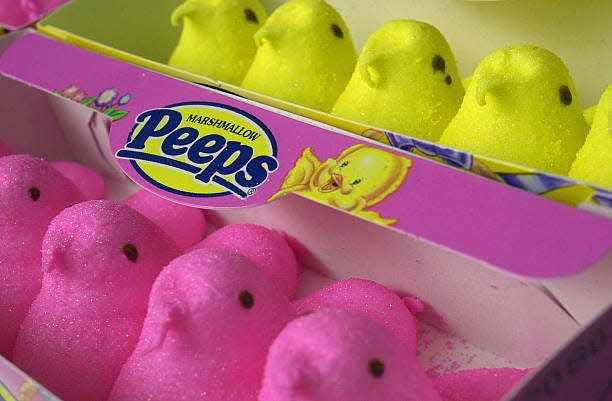
Consumer Reports, an advocacy and research nonprofit, is calling on the maker of Peeps candies to stop using Red Dye 3 in its products.
According to a Monday news release, Consumer Reports sent a letter to Just Born Quality Confections earlier this year – urging the candy manufacturer to remove Red Dye 3 from its products like Peeps. The company has not responded, Consumer Reports said, prompting the nonprofit to start a petition.
The announcement arrives amid a larger push among a handful of consumer advocacy groups to ban the use of Red Dye 3, also known as FD&C Red No. 3 or erythrosine, in food products nationwide.
The Center for Science in the Public Interest, a consumer food safety organization, and 23 other groups and scientists (including Consumer Reports) started a petition last fall calling on the U.S. Food and Drug Administration to formally remove Red Dye 3 from the list of approved color additives in foods, dietary supplements and oral medicines.
In a statement sent to USA TODAY on Wednesday, the FDA said that it’s “actively reviewing” the petition. The agency also noted that “FD&C Red No. 3 has been previously evaluated by the FDA.”
What’s open and closed on Good Friday?: What to know about bank, school and mail service hours
The Child Tax Credit: How much is it for 2023? Here’s what you need to know about qualifying.
Advocates of removing Red Dye 3 from food and other products have pointed to health concerns. Previous research has found that Red Dye 3 can cause cancer in animals, among other health impacts.
Here’s what you need to know.
What is Red Dye 3?
Red Dye 3 is a color additive that used in thousands of products in the U.S. According to the FDA, FD&C Red No. 3 is regulated by the agency and is a “certified color” for food and ingested drugs.
According to the Environmental Working Group, a nonprofit research and advocacy organization, nearly 3,000 food products on the market today contain Red Dye 3.
“The dye is used in many processed foods, from snack cakes to imitation bacon bits, but it’s usually found in decorated cookies and candies, especially seasonal candies. Brands … use it to create their bright, vibrant colors,” the EWG writes.
But “synthetic dyes have been linked to a wide array of health harms,” EWG, which also joined the petition sent to the FDA, adds.
“FDA requires all color additives to be listed on product labels so that they can be identified by consumers (see “Color Additives Questions and Answers for Consumers”),” the agency says. “Consumers who wish to limit the amount of color additives in their diets may check the food ingredient list on labels.”
California banning Skittles?: Lawmaker fights confusion over bill targeting chemicals

Health impacts of Red Dye 3
Previous studies have found that high doses of Red Dye 3 can cause cancer in animals.
While the additive is still currently approved for use in food and ingested drugs, the FDA banned the use of Red Dye 3 in cosmetics and externally applied drugs in 1990, citing “a carcinogenic response in rats.”
There is yet to be sufficient research linking the color additive to cancer in humans, but the findings have still prompted concerns. Additional research has found links to negative impacts on the behavioral health in children.
The 2021 report by the California Environmental Protection Agency’s Office of Environmental Health Hazard Assessment found that “synthetic food dyes can result in hyperactivity and other neurobehavioral problems in some children” and that “current federal levels for safe intake of synthetic food dyes may not sufficiently protect children’s behavioral health.”
International Association of Color Manufacturers pushed back on these findings, saying there was “insufficient scientific evidence.”
“Colors are safely used in a wide variety of consumer products, are among the most widely studied food ingredients, and are subject to strict global regulatory requirements,” IACM said at the time.
Is Red Dye 3 in Peeps?
And, in case you’re wondering whether or not Red Dye 3 will be in your Easter candy this year, Consumer Reports says the additive is also found in purple and pink Peeps.
According to Consumer Reports, Just Born products that contain Red Dye 3 include:
-
Peeps Pink Marshmallow Chicks and Bunnies.
-
Peeps Lavender Marshmallow Chicks and Bunnies.
-
Hot Tamales.
-
Peeps Hot Tamales Marshmallow Chicks.
-
Party Cake Peeps.
-
Peeps Fruit Punch Marshmallow Chicks.
-
Peeps Wildberry Marshmallow Bunnies.
In its announcement of the petition asking Just Born to stop using Red Dye 3, Consumer Reports cited the research linking the additive to cancer in animals, as well as negative impacts on children’s behavioral health.
“Just Born Quality Confections should stop making its iconic marshmallow treats with this dangerous food chemical since other less risky alternatives are readily available,” senior staff scientist for Consumer Reports Michael Hansen said in a statement.
In a statement sent to USA TODAY on Wednesday, Just Born said that the company manufacturers all of its candy in compliance with FDA regulations – again noting that the FDA currently approves FD&C Red No. 3 as a colorant for food, including candy.
“We also provide consumers with information on our packaging and our websites to help them make informed choices about our products,” Just Born stated.
Just Born added that it’s “continually exploring opportunities to provide expanded options for our consumers, including colors derived from natural sources that can deliver the same visual impact and stability as their certified counterparts.”
More coverage from USA TODAY
This article originally appeared on USA TODAY: Peeps candy, chemical linked to cancer prompt Red Dye 3 removal push






